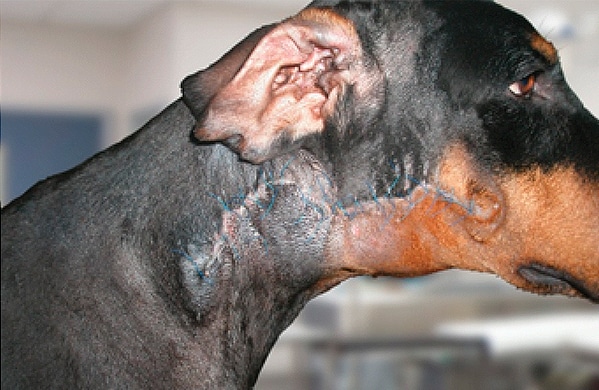
When do wounds require Specialist care?
Any problematic wound has the potential to benefit from a Specialist opinion on how best to aid the healing process and therefore try to minimise the detrimental effect that long-term wound management can have on your pet.
What are the benefits of wound care?
All patients referred for treatment of problematic wounds are assessed by Specialist soft tissue surgeons with a particular interest in wound management. The soft tissue surgery Specialists regularly provide continuing education to veterinary surgeons in general practice on the subject of wound management.
Continuity of care is critical during wound management in order to interpret the changes that have occurred since the previous examination or dressing change. Whenever possible the same Specialist will assess the wound at each dressing change. This allows the dressings that are applied to be tailored specifically to the healing mechanisms in progress and to be altered if appropriate. Digital photographs are often used to keep an accurate record of the wound at each stage, to further aid in the assessment of healing and to help to guide management options.
In some cases, a wound will benefit greatly from a relatively intensive treatment plan in the initial stages of care. An affected pet can be admitted to our hospital for daily wound treatment, and then cared for on an out-patient basis once healing is underway.
How are wounds assessed for treatment at North Downs Specialist Referrals?
The assessment process typically involves several stages:
- A detailed medical history is obtained from both you and your vet – it is important that the Specialist is fully aware of any medical conditions that may affect your pet’s ability to heal or fight infection
- Consideration of the cause of the wound (e.g. barbed wire, dog bite, infection)
- Consideration of treatment that has been used prior to referral and any progress that has been made
- Removal of the dressing and detailed investigation of the wound itself – this may require sedation or a short anaesthetic in order to allow the surgeon to fully explore the lesion
- Samples (biopsies) can be taken when appropriate for laboratory examination and culture to identify any bacteria that may be present.
After the initial assessment the surgeon will summarise his findings and give an indication of the likely timeline and level of treatment that will be required to get the best and most rapid result. Management of wounds often requires careful assessment on a day-by-day basis, therefore it is not possible to give very detailed advance predictions of exactly what will be required. The treatment plan will need to remain somewhat flexible in order to allow the surgeon to adapt to changes that occur in the wound itself.
What techniques are available to treat wounds at North Downs Specialist Referrals?
The surgeons regularly employ the following techniques to manage wounds:
- Active dressings – these dressings include a component to increase the healing process – materials including alginate, honey and silver can be used under appropriate circumstances
- Secondary intention healing – this is the type of healing that occurs without the wound being stitched up – an example in a person would be healing under a scab, after falling over for example. Many wounds will heal naturally without the need for reconstructive surgery. The Specialist surgeon will advise whether this can be achieved and tailor the dressings applied to optimise the natural healing process
- Direct closure – following successful treatment of ongoing tissue damage, infection etc. some wounds can be closed directly (stitched up) in the operating theatre
- Free skin grafts – this is where skin is harvested from a healthy site and placed elsewhere on the body to fill the wound
- Reconstructive techniques – there is a wide range of skin reconstructive techniques, involving different types of skin flaps of different types. Our Specialist soft tissue surgeons are trained in using many advanced types of reconstructive wound repair techniques
How long will the treatment take?
Successful wound management can be challenging and time consuming in both human and veterinary patients. The tissues involved often need to be allowed time to react appropriately to the damage that caused the wound in the first instance, and they then need time to respond to the treatment which is being administered. Whilst the management will aim to help the natural processes to be as efficient as possible, wound care can require treatment over a quite prolonged period – this may extend to several weeks in some cases.
Our Specialist will tailor the treatment regime to the wound but will also consider and discuss your situation, for example in terms of travelling with your pet to us for appointments. Patients can be admitted to the hospital to help them reduce travelling commitments and to provide any additional veterinary and nursing care which may be required, or alternatively treatment can be provided on an outpatient basis, depending upon the individual set of circumstances.
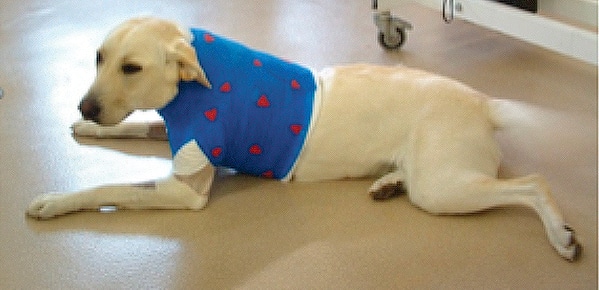
A happy patient following a wound care appointment
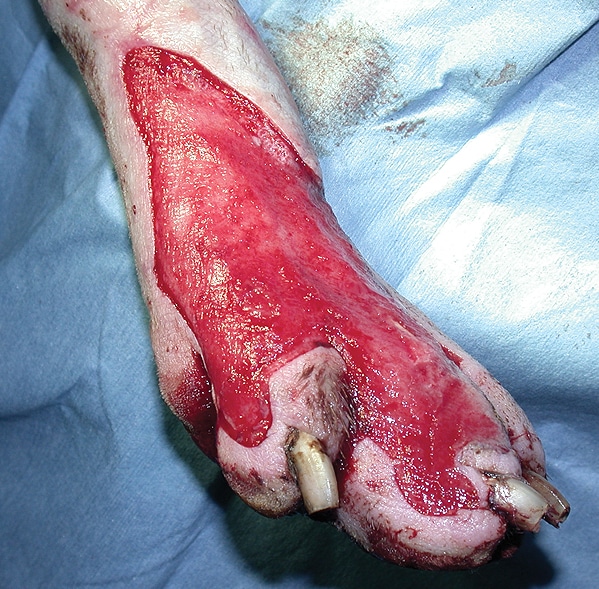
A skin defect following a road traffic accident that was treated by application of a free skin graft (see below). Before the skin graft procedure was performed, the wound was carefully managed using different dressing techniques to ensure the tissue was suitable to receive the graft
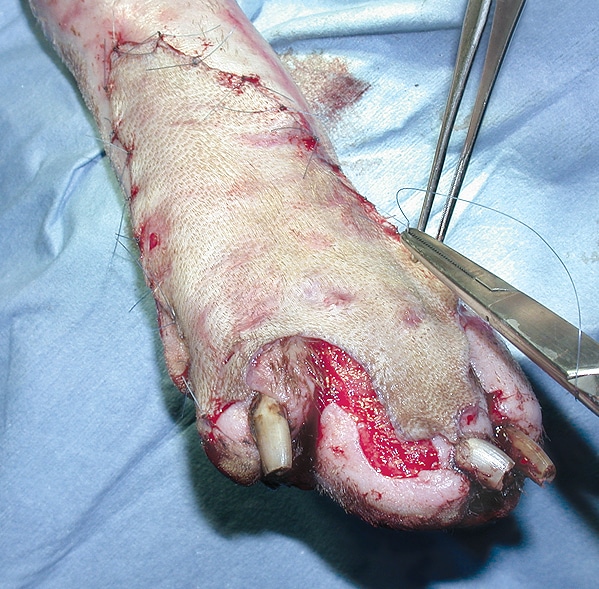
This intra-operative photograph shows the free skin graft being sutured in position. The potential success or failure of this procedure was dependent not only upon the quality of the surgical procedure, but also in large part upon the patient’s post-operative management, including the dressings which were applied following the operation
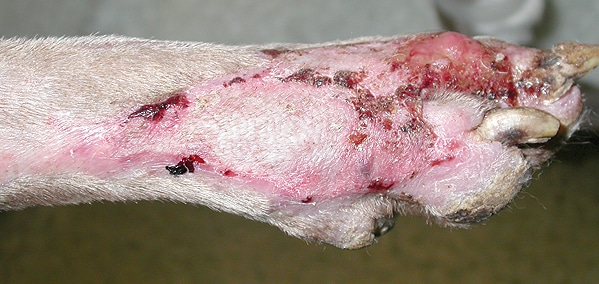
This picture was taken three weeks following graft application. The graft has incorporated into the previous defect and the small area of raw tissue remaining is small enough to be managed by continued dressing changes
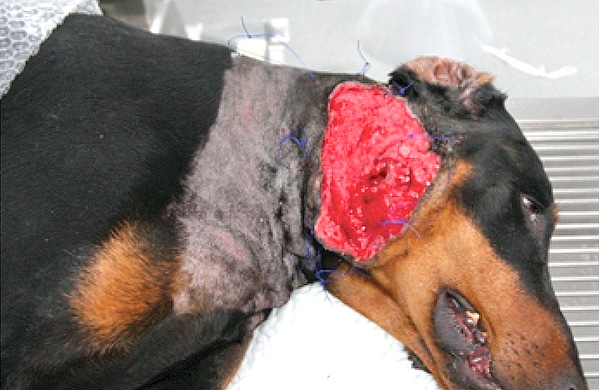
The picture, shown above, shows a sedated dog that was presented a week earlier with a severe wound to the side of the face. The photograph shows the healthy (if slightly gory looking!) wound bed following intensive wound management. The wound was then successfully closed by a surgical procedure – see picture below.
Arranging a referral for your pet
If you would like to refer your pet to see one of our Specialists please visit our Arranging a Referral page.
